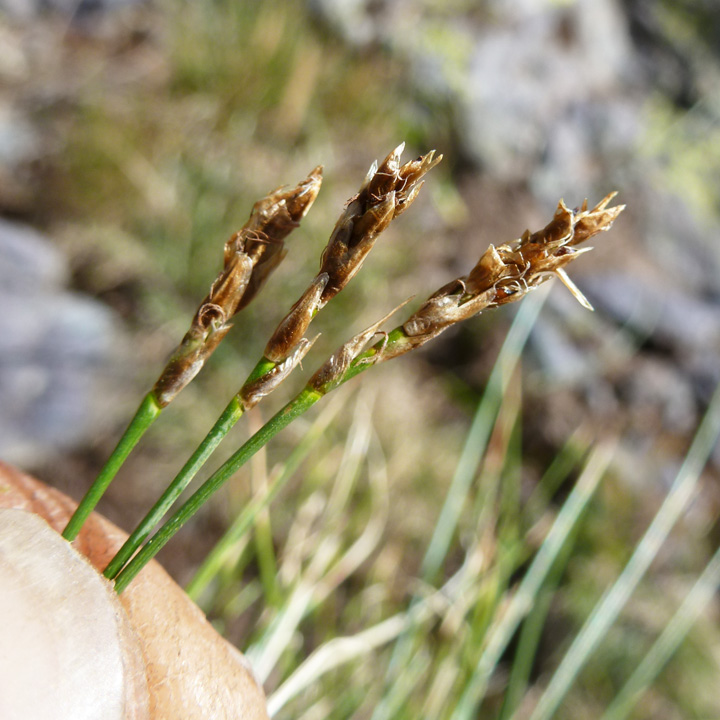Cyperaceae
|
Cyperaceae |
|
|
Herbs, annual or perennial, cespitose or not, rhizomatous or not, stoloniferous or not. Roots fibrous, principally adventitious. Stems (culms) usually trigonous, occasionally terete, rarely compressed, usually solid, rarely hollow or septate. Leaves basal and/or cauline, alternate, usually 3-ranked, rarely 2-ranked or multi-ranked, bases forming cylindric sheaths enclosing stem, margins usually fused; junction of sheaths and blades often with adaxial flaps of tissue or fringes of hair (ligules); blades frequently absent from some basal leaves, rarely from cauline leaves, when present divergent or ascending, flat, folded, plicate, rolled, or terete, linear, venation parallel. Primary inflorescences (spikelets) a shortened axis; glumaceous bracts (scales) 1-many, spirally arranged, sometimes 2-ranked, usually appressed or ascending; scales usually all fertile, each subtending a single flower, sometimes proximal and/or distal scales empty; lateral spikes often with basal, usually empty, usually 2-keeled scale (prophyll); occasionally prophyll subtending and enclosing rachilla, bearing 1 pistillate, sometimes (0-)3 staminate flowers and empty scales (Carex, Cymophyllus, and Kobresia). Secondary inflorescences panicles, often modified to corymb, pseudoumbel, cyme (anthela), raceme, spike, or capitulum (head), rarely single spike, usually subtended by foliaceous or, less frequently, glumaceous bracts; secondary inflorescences sometimes simulating spikelets (Carex, Cymophyllus, and Kobresia). Flowers hypogynous, bisexual in most genera, unisexual in Scleria, Carex, Cymophyllus, and Kobresia; perianth absent or with (1-)3-6(-30) bristles and/or scales, usually falling off with fruit; stamens usually (1-)3, rarely more, usually distinct; anthers basifixed; pistils 1, 2-3(-4)-carpellate, fused, locule 1; style undivided or branches 2-3(-4); stigma sometimes papillate. Fruits achenes, usually trigonous or biconvex; pericarps thin (except in Scleria). Seeds 1; testa thin, free from pericarp; embryo basal; endosperm abundant. x = 5-ca. 100. No consensus exists regarding the number of genera and the overall relationships of genera within Cyperaceae. The most recent account of the family (P. Goetghebeur 1998) recognized 104 genera distributed among 4 subfamilies and 14 tribes. That arrangement differs somewhat from that of J. Bruhl (1995). With one minor exception the arrangement of the family here follows that of Goetghebeur. The family is characterized by the occurrence of a number of unusual cytological features including: (1) chromosomes with diffuse centromeres, (2) post-reductional meiosis, and (3) pollen grains formed from tetrads in which 3 of the 4 microspores fail to develop. The first two features are found in at least some Juncaceae and are unique to the two families. Juncaceae also have pollen in tetrads, but in that family all four microspores produce pollen grains. Some species in some genera of Cyperaceae (particularly Eleocharis) possess chromosomes with localized centromeres (S. S. Bir et al. 1993). The wide range of chromosome numbers found in Cyperaceae is largely because of agmatoploidy; polyploidy has been hypothesized for some genera, especially Eleocharis, although polyploidy has not been demonstrated unequivocally. Because of morphologic similarities in vegetative and inflorescence characters, the family has commonly been associated with Poaceae. Cytological features discussed above clearly indicate that to be a superficial similarity. Data from rbcL studies also support the view that Cyperaceae and Poaceae are not closely related (M. R. Duvall et al. 1993b; G. M. Plunkett et al. 1995); they do support the concept of close relationship between Cyperaceae and Juncaceae. For most families of flowering plants the phenological data given are flowering times. Because most Cyperaceae cannot be reliably identified when in flower, in this volume fruiting time is given for all species by season, sometimes qualified by early, mid, or late, or by months. The fruiting time has been interpreted broadly to include the period when the fruit is more or less fully formed but not yet ripe. The fruiting period provided covers the entire range of the taxon. Quite a difference between fruiting periods in different parts of the range of the species may well occur, especially for widespread species and species with extensive elevation range. For a recent, comprehensive review of the economic importance of Cyperaceae, see D. A. Simpson and C. A. Inglis (2001).
|
|
